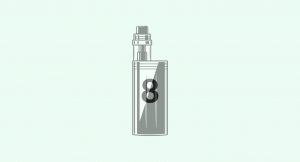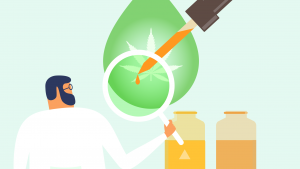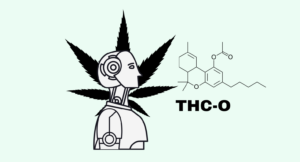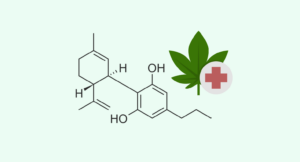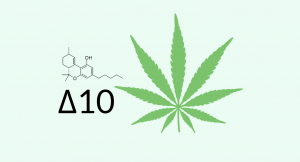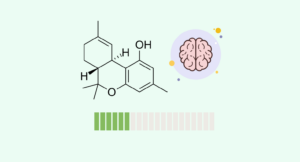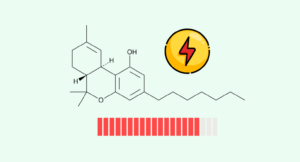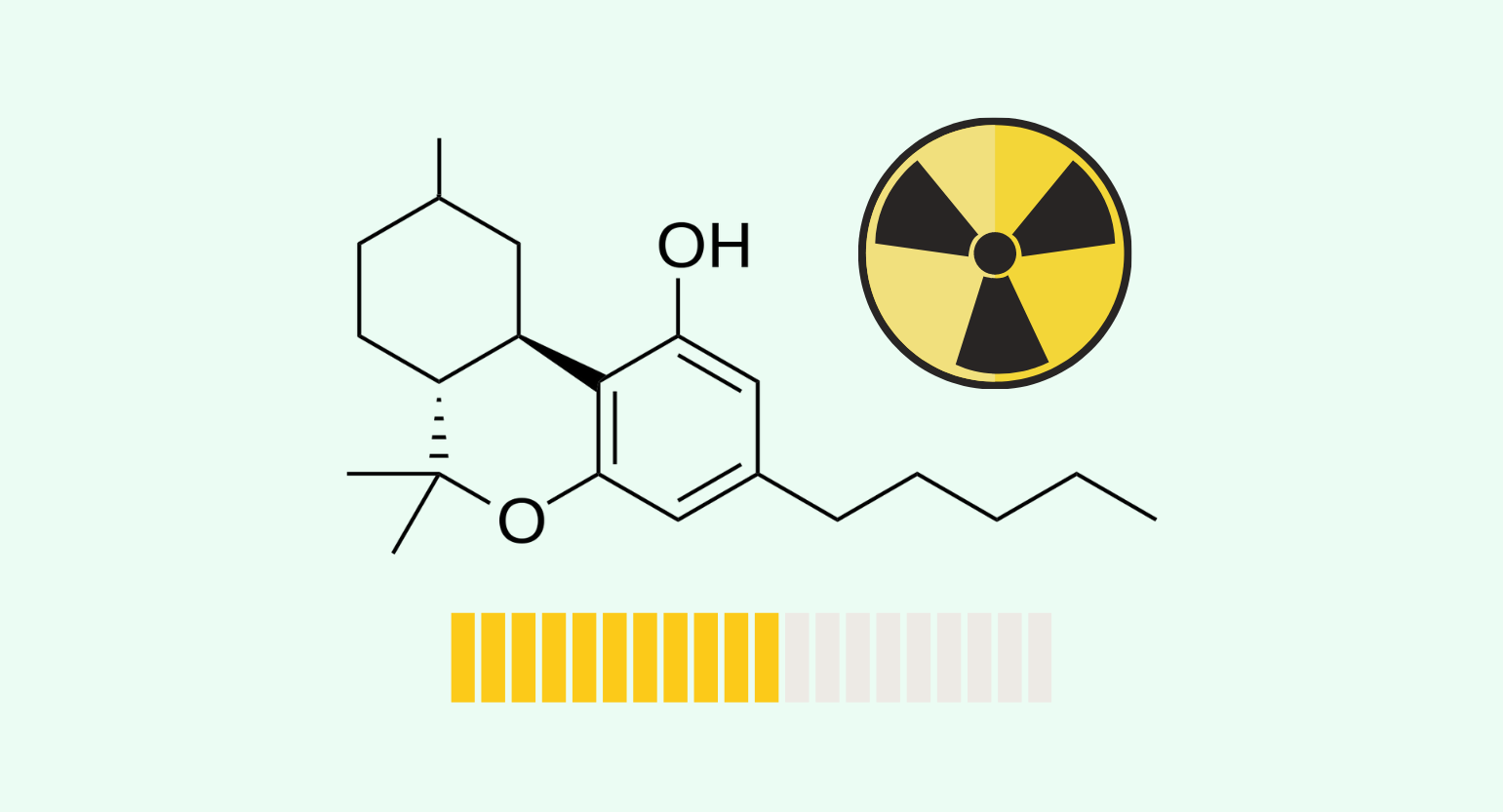
Evidence based
What is HHC? Hydrogenated Cannabinoids & Apocalypse-Ready THC
HHC (hexahydrocannabinol) is the most stable form of THC.
It’s resistant to heat and UV radiation & has a substantially longer shelf-life than THC.
We’re officially in the alternate cannabinoids era. Conventional delta 9 THC and CBD simply aren’t enough.
There’s now a whole suite of alternative cannabinoids. Delta 8 THC for a more relaxing experience, delta 10 THC for stimulation and energy, or the powerful THCP and THC-O for a psychedelic-like experience.
Now, there’s another form called HHC.
HHC is a truly apocalypse-ready cannabinoid. This stuff will remain viable for many, many years. When it finally comes time to colonize mars, HHC is likely the cannabinoid astronauts will choose to take with them.
Check out our list of the best HHC gummies and best HHC vape carts for 2022.
What is HHC?
HHC stands for hydroxyhexahydrocannabinol. There are several isomers of this hydrogenated form of THC.
HHC is to THC, what margarine is to butter.
By saturating the molecule with hydrogen atoms, the shelf-life of this cannabinoid is extended substantially without affecting the effect profile too much.
HHC is naturally occurring [1], but only in trace concentrations. For companies to sell this cannabinoid, they’re going to need to make it in a lab.
There are four main types of HHC:
- 9-OH-HHC — 9α-hydroxyhexahydrocannabinol(CAS# 36028-45-2)
- 7-OH-HHC — 7-hydroxyhexahydrocannabinol (CAS# 64663-39-4)
- Cannabiripsol — (6aR,9S,10S,10aR)-9,10-dihydroxyhexahydrocannabinol (CAS# 72236-32-9)
- HU243 — 11-Hydroxy-3-(1′,1′-dimethylheptyl)hexahydrocannabinol (CAS 140835-14-9)
Others include 10α-hydroxyhexahydrocannabinol, 10aR-hydroxyhexahydrocannabinol, 7-oxo-9α-hydroxyhexahydrocannabinol, 1S-hydroxycannabinol, 8-oxo-Δ9-THC, and Δ9-THC aldehyde A.
Basically, HHC is THC without any double bonds in its chemical structure. It’s the exact opposite molecule as CBN (cannabinol), which forms as THC breaks down and gains additional double-bonds.
With HHC, all the double bonds have been broken and replaced with hydrogen (AKA hydrogenation).
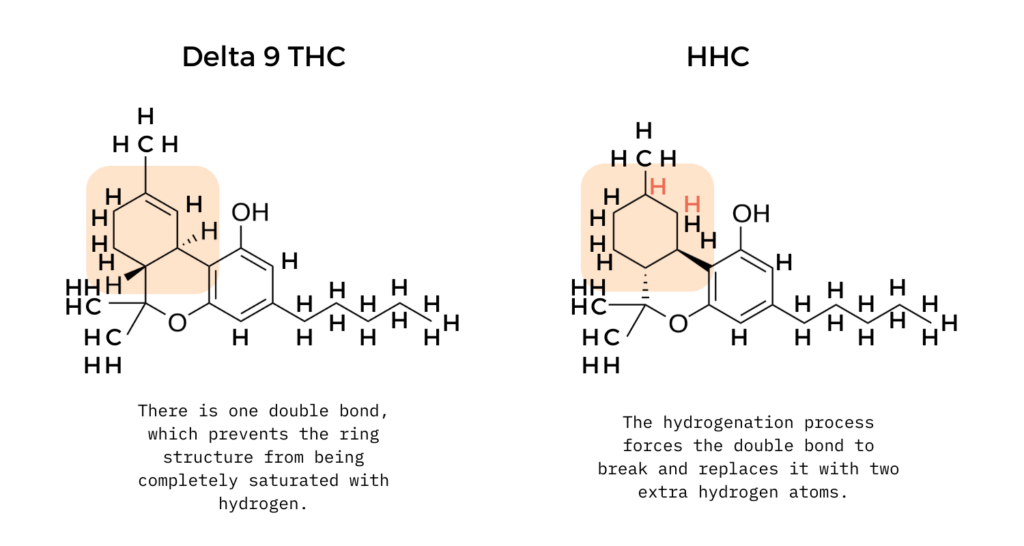
The difference is subtle, but this changes the geometry of the molecule, along with its binding affinity for the CB1 and CB2 endocannabinoid receptors and TRP pain receptors.
This change also makes the molecule much more stable — meaning it’s going to have a longer shelf-life before losing its potency than other forms of THC. This happens for the same reason that hydrogenated vegetable oils last so much longer than regular vegetable oils. By saturating the chemical structure, it becomes less susceptible to oxidation and breakdown.
This compound is also much more resistant to improper storage or exposure to heat and UV light. HHC would make for a perfect apocalypse cannabinoid because of how long it remains viable in storage.
Delta 9 THC, the most abundant naturally-occurring form of THC, but it’s also the least stable. As it oxidizes, it loses hydrogen atoms and forms two new double bonds on its top ring structure. When this happens, THC becomes CBN (cannabinol) — which has only 10% of the psychoactivity of THC.
Key Points: What is HHC?
- HHC is a hydrogenated (semi-synthetic) form of THC
- HHC offers similar effects & potency compared to THC
- HHC has a substantially longer shelf-life & is more resistant to high heat or UV exposure
- The safety profile of HHC is still unclear, but there’s no evidence to suggest it’s dangerous
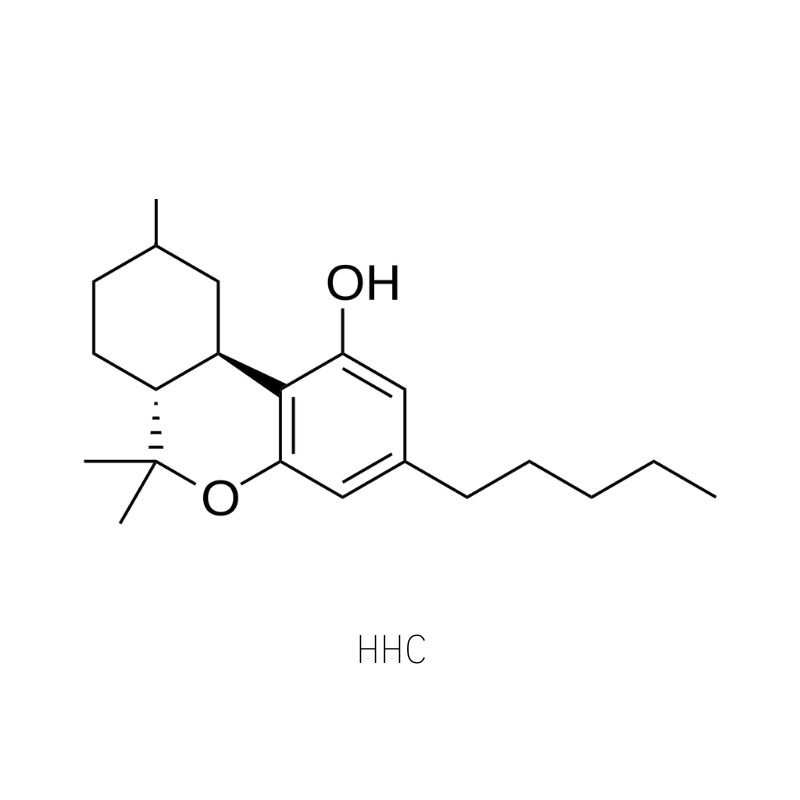
What Are The Effects of HHC?
HHC has very similar effects as THC. It produces feelings of euphoria and stimulation, altered visual and auditory perception, changes in heart rate and body temperature, and altered headspace and cognition.
Many users report the effects of HHC are similar to that of delta 8 THC in terms of being more heavily weighted towards relaxation than stimulation. HHC is more potent than delta 8 but slightly less potent than delta 9 THC.
HHC is still very new, so there aren’t many studies available to evaluate its potential therapeutic effects — but so far, it seems this cannabinoid offers most of the same therapeutic effect profile as other forms of THC. There’s even been some animal testing that showed beta-HHC possesses notable painkilling effects when tested on rats [2].
The potential benefits of HHC include:
- May help manage chronic pain
- May reduce inflammation
- May promote deeper, more restorative sleep
- May alleviate nausea or vomiting
- May alleviate anxiety (may also increase anxiousness)
The real benefit of this cannabinoid comes from its impressive shelf-life, more so than its physical effects. It offers very similar benefits to THC but comes in a much more stable form.
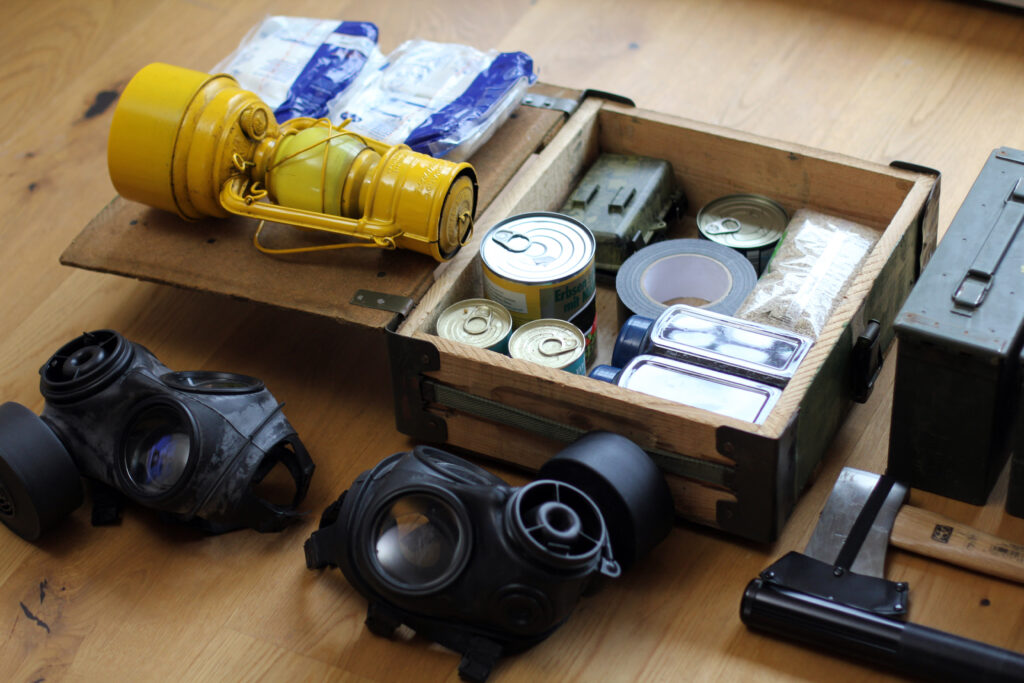
Is HHC Legal?
There’s a lot of debate around the legality of cannabinoids like HHC or delta 8 THC. Companies that intend to sell HHC, such as Bearly Legal claim it’s entirely legal because it’s naturally occurring. However, like many of the other THC analogs, it doesn’t occur in any meaningful amounts in nature and therefore must be made in a lab in order to get any usable supply.
Whether this constitutes a natural or synthetic compound is up for debate.
The argument that HHC is naturally-derived, comes down to its presence in hemp and marijuana flower. If caffeine is made in a lab, we don’t call it synthetic caffeine — it’s just caffeine.
The argument that HHC is synthetically-derived comes down to the fact that in order to get any meaningful quantities, we need to convert it from other compounds using chemicals and technology.
If deemed natural, as long as the final product remains below the legal threshold of 0.3% delta 9 THC and the starting material is derived from hemp, it’s legal on a federal level.
If deemed synthetic, HHC is illegal on a federal level with the same repercussions as delta 9 THC.
Related: What are synthetic cannabinoids?
Currently, the legality of the entire alternate cannabinoid market is a big question mark. While some interpretations make these compounds appear legal, there are other laws that could make these compounds illegal already — such as the Federal Analog Act. This law makes any analog of a listed Schedule I drug (such as delta 9 THC) illegal by proxy.
Most countries have similar laws and also list THC as a prohibited substance.
Use these products at your own risk.
How is HHC Made?
There are many ways to make HHC. Older methods involved the use of acids (synthetic gastric juice) to convert THC to HHC, while newer methods involve the conversion of a terpene called citronellal or hydrogenation using catalysts like palladium.
Because THC itself is illegal, and the companies that are making and selling HHC are largely centered around the “legal” market, HHC must be made from something other than THC in order for the manufacturing plant to avoid breaking any laws.
One way around this is to convert CBD to HHC using artificial gastric juice. This produces 9α-OH-HHC, 8-OH-iso-HHC, and delta 9 THC. The delta 9 THC must then be separated and discarded from the final product.
Let’s cover each process in more detail:
1. Hydrogenation of THC to HHC
Any isomer of THC can be used to make HHC through hydrogenation — including delta 8, delta 9, and delta 10 THC. Most of the processes outlined convert THCA to make HHC.
The process involves subjecting concentrated THC to high pressure, hydrogen atoms, and a catalyst containing inert metals such as iridium, palladium, rhodium, nickel, ruthenium, platinum, or rhenium.
The reaction basically forces the double bond in the THC structure to break, causing the molecule to become unstable. Hydrogen is needed to stabilize the molecule (this is why it’s called, hydrogenation — hydrogen molecules are “added”).
A recent patent (No. 20160324909A1) was submitted for the creation of hydrogenated cannabis oil (HCO) by an organic chemist by the name of Mark Scialdone.
Example process outlined in Scialdone’s patent application:
- THCA-rich cannabis extract is dissolved in ethanol
- Palladium/carbon catalyst is added (10%) and stirred in
- Hydrogen gas is bubbled through the mixture under pressure and left for several hours
- The mixture is filtered through Celite to remove the catalyst
- Solvent removed via rotary evaporation
In another US patent (No. 2419937A), hydrogenation of THC to HHC was outlined using a catalyst called “Adams Catalyst” — which consists of platinum dioxide.
Caution: This reaction needs to be done under a vacuum and in the presence of inert gas. Exposure to oxygen in the air can cause it to combust. Only experienced chemists using proper chemistry equipment should attempt this reaction.
2. Conversion of CBD to HHC Using Artificial Gastric Juice
An older method outlined a process for converting CBD to 9α-OH-HHC, 8-OH-iso-HHC, and Δ9-tetrahydrocannabinol using artificial gastric juice [3]. There haven’t been many updates on this procedure since the initial article published in 2007.
3. Hydrogenation of Terpenes to HHC
HHC can also be made from the terpenes citronellol or L-carvone using various catalysts, high temperature, pressure, and hydrogen atoms.
A process has been suggested (source unclear) that involves the conversion of L-carvone to HHC using a catalyst called Wilkinson’s catalyst (tris-triphenylphosphine rhodium chloride).
A research group published a method of converting citronellal to HHC back in 2008 using the hetero-Diels-Alder reaction [4].
Is HHC Safe?
There have never been any safety studies for HHC to date — so any information currently available regarding the safety of this compound is speculative.
With that said, the popularity of HHC is on the rise, and there have already been a lot of people using it on a daily basis. There has not yet been any reports of severe side effects. Preliminary research suggests it shares a comparable safety profile to THC.
The major cause for concern with HHC is the use of harsh chemicals during the manufacturing process and the formation of unwanted chemical byproducts that may make their way into the final product.
Always check third-party lab tests for heavy metals (that includes tests for iridium, palladium, rhodium, nickel, ruthenium, platinum, and rhenium) and chemical solvents (including hexane, benzene, heptane, toluene, and butane).
What Are the Side Effects of HHC?
There are some side effects that have been reported. These effects are similar to the side effects experienced with high-dose THC:
- Anxiety
- Insomnia
- Rapid heart rate
- Dizziness & confusion
- Increased hunger levels
- Dry mouth
- Red eyes
- Paranoia

Will HHC Show Up On a Drug Test?
One of the main selling points used to market this compound is that it doesn’t register on conventional 12-panel drug tests. This has a lot of people interested because the other THC alternatives, such as delta 8 and delta 10 THC, will both contribute to a failure on urine or blood tests for THC.
Whether HHC can truly avoid drug tests or not is still up for debate, but anecdotal evidence of people testing this have seemed to settle that this is not the case.
At least some of the HHC is metabolized into 11-hydroxy-THC, which is the primary metabolite of THC drug tests are designed to detect.
HHC vs. THC: What’s The Difference?
Structurally, HHC and THC are nearly identical. THC normally has one double bond in its top ring structure, which is absent in HHC.
This makes HHC more stable than THC long-term and alters its ability to bind with various receptors in the body.
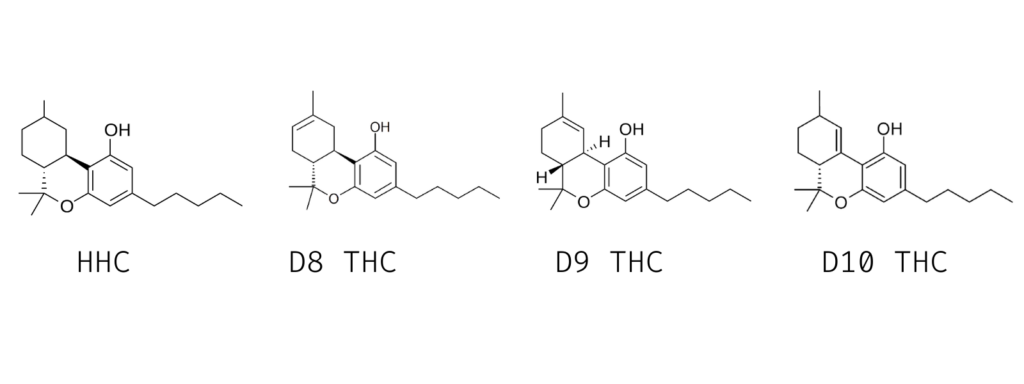
Overall, HHC is considered about 80% as potent as THC (some suggest it’s stronger) but otherwise shares virtually identical traits.
The effect profiles of HHC and THC are very similar. Any form of THC that has more than three carbons in its side chain has psychoactive effects. Basically, the more carbons in the chain, the stronger the psychoactive effects.
Ranking the potency of Tetrahydrocannabinols (Weakest to Strongest):
- THCC — one carbon and is non-psychoactive.
- THCV — three carbons and is about 25% as potent as THC.
- THC —delta 8, delta 9, and delta 10 all have five carbons. The delta 9 isomer is the strongest of the three.
- HHC — five carbons and is placed somewhere in between the potency of delta 8 THC and delta 9 THC.
- THC-O-acetate — a prodrug of delta 9 THC. It’s stronger because it has a higher bioavailability than natural THC.
- THCP — seven carbons and is the strongest of them all — somewhere between 5 and 33 times as potent as delta 9 THC
Is HHC Found In Nature?
Technically, yes, various forms of HHC have been found in Cannabis sativa plants. It’s formed as a degenerative byproduct as the THC breaks down. This is a similar case for delta 8 THC, which is technically found in nature, but isn’t produced by the cannabis plant directly.
There have been a few studies to suggest HHC is found in nature (in minuscule concentrations).
HHC was first discovered in hemp back in 1979. The form of HHC found is called cannabiripsol — (6aR, 9S, 10S, 10aR)9,10-dihydroxy-hexahydrocannabinol [5].
This was later confirmed in 2015 along with 8α-hydroxy-Δ9-tetrahydrocannabinol, 8β-hydroxy-Δ9-tetrahydrocannabinol, 10α-hydroxy-Δ8-tetrahydrocannabinol, 10β-hydroxy-Δ8-tetrahydrocannabinol, 10α-hydroxy-Δ9,11-hexahydrocannabinol, 9β,10β-epoxyhexahydrocannabinol, and 11-acetoxy-Δ9-tetrahydrocannabinolic acid A [6].
Another study from 2016 found several other forms of HHC in a sample of high-potency Cannabis sativa [1]:
- 9α-hydroxyhexahydrocannabinol
- 7-oxo-9α-hydroxyhexa-hydrocannabinol
- 10α-hydroxyhexahydrocannabinol
- 10aR-hydroxyhexahydrocannabinol
- Δ9-THC aldehyde A
- 8-oxo-Δ9-THC
- 10aα-hydroxy-10-oxo-Δ8-THC
- 9α-hydroxy-10-oxo-Δ6a10a-THC
- 1S-hydroxycannabinol (hydroxylated cannabinol)
How HHC Is Formed Naturally
Delta 9 THC is the most abundant form of THC in the cannabis plant, by far. This goes for both hemp and marijuana strains.
As delta 9 THC breaks down, most of it is converted to CBN, while a very small concentration is converted to delta 8 THC, delta 10 THC, or HHC.
Because of how abundant delta 9 THC is in the plant, it can be extracted and concentrated without any additional effort.
All of the other forms of THC are present in concentrations too low for this method to be feasible. Companies would need to extract massive quantities of marijuana to obtain any meaningful supply of this compound.
Instead, companies make HHC and other forms of tetrahydrocannabinols through isomerization or hydrogenation processes. Delta 8 and delta 10 are made through the isomerization of CBD, while HHC is made through a hydrogenation process involving THC that’s either converted from CBD or extracted in its natural form. HHC can also be made from the terpene citronellol.
Chemical Structure of HHC
There are a lot of THC analogs on the market today, and several others are expected to hit the market within the next couple of months.
There are two variables of THC that can be tweaked to create a new analog:
- The location of the double-bond in the top ring structure on the THC molecule
- The length of the side chain extending off the bottom ring structure (benzene ring) on the THC molecule
HHC is an alteration to the first variable. It’s characterized by a lack of any double bonds on the first ring structure.
Here are a few of the different variants that can be made by playing around with the double bonds in the THC molecule:
- Double bond at the tenth carbon — delta 10 THC
- Double bond at the ninth carbon — delta 9 THC
- Double bond at the eight carbon — delta 8 THC
- Double bond at the fifth or seventh carbon — delta 7 THC
- Maximum number of double bonds — CBN
- No double bonds — HHC

(R)-HHC vs. (S)-HHC: What’s The Difference?
You may see two different stereoisomers listed on HHC lab reports. Stereoisomers are compounds that have the same shape and structure, but different three-dimensional shape. It’s sort of like your right and left hand — they’re the same, but the thumb on one hand is on the left, and the thumb on the other is on the right.
(R)-HHC is active, while (S)-HHC is inactive.
Both stereoisomers are formed at the same time, but the ratio of each can shift depending on the type of THC used to make it.
However, in practice, most preparations end up producing about 50/50 mix of both isomers.
Some reports suggest delta 10 conversion has the highest efficiency for producing the 9R isomer (90%) but this needs to be confirmed.
It’s possible to concentrate the active (R)-HHC (called a racemic mixture), but the process is very complicated and cost-prohibitive in most cases. The majority of HHC products you’ll find on the market will have roughly equal portions of (R) and (S) HHC.
Where Can I Buy HHC?
Currently, there are no good, reputable sources of HHC. There are a lot of companies interested in selling this cannabinoid — especially because of its alleged ability to avoid detection on standard THC tests. However, this isn’t exactly true — HHC can be tested for, but only a few labs (KCA Labs and the Colorado Chromatography) have reliable testing parameters.
Look for products tested with KCA Labs to be the most confident in the results.
Not only is it critical that HHC products are tested, but companies that don’t should be actively avoided.
The State of HHC in the Cannabinoid Industry:
| Company | Type of HHC | Testing Company | Heavy Metal Testing? | Link to Test | Verdict |
| Area 52 | Cannabiripsol | KCA Labs | ✅ | Link | Recommend 🚀 |
| Moonwalkr | Unspecified | Kind Spectrum | ❌ | Link | Caution ⚠️ |
| Pure Kana | Cannabiripsol | KCA Labs | ✅ | Link | Caution ⚠️ |
| Exhale Wellness | Not Tested | Clip Labs | ❌ | Link | AVOID 🚫 |
| Fuked Up | Unspecified | Accurate Test Lab | ❌ | Link | Caution ⚠️ |
| Forge Hemp | Unspecified | Gobi Hemp | ❌ | Link | Caution ⚠️ |
| Bearly Legal | None Detected | KCA Labs | ❌ | Link | AVOID 🚫 |
| Delta Extrax | None Detected | SD Pharm Labs | ❌ | Link | AVOID 🚫 |
| Diamond CBD | Unspecified | Accurate Test Lab | ❌ | Unverifiable | AVOID 🚫 |
Be careful where you buy HHC. There are a lot of scam companies that release new cannabinoid products early to take advantage of the lack of competition. They’re able to enter this realm so early because the product contains little to none of the actual cannabinoid at all. Most of the time, they’re complete scams with products that could contain any number of unknown and potentially harmful chemicals.
At the moment, it’s difficult to find high-quality HHC. Only PureKana has a convincing lab panel and lists both the type of HHC they’re using and proves the absence of heavy metals. However, they don’t test for palladium, rhodium, or rhenium (which are common catalysts for HHC conversion).
No matter where you buy your HHC, proceed with caution until more high-end and reputable vendors enter the space.
References
- Ahmed, S. A., Ross, S. A., Slade, D., Radwan, M. M., Khan, I. A., & ElSohly, M. A. (2015). Minor oxygenated cannabinoids from high potency Cannabis sativa L. Phytochemistry, 117, 194-199.
- Bloom, A. S., Dewey, W. L., Harris, L. S., & Brosius, K. K. (1977). 9-Nor-9-hydroxyhexahydrocannabinol a cannabinoid with potent antinociceptive activity: comparisons with morphine. J Pharmacol Exp Ther, 200, 263-270.
- Watanabe, K., Itokawa, Y., Yamaori, S., Funahashi, T., Kimura, T., Kaji, T., … & Yamamoto, I. (2007). Conversion of cannabidiol to Δ 9-tetrahydrocannabinol and related cannabinoids in artificial gastric juice, and their pharmacological effects in mice. Forensic Toxicology, 25(1), 16-21.
- Lee, Y. R., & Xia, L. (2008). Efficient one-pot synthetic approaches for cannabinoid analogues and their application to biologically interesting (−)-hexahydrocannabinol and (+)-hexahydrocannabinol. Tetrahedron Letters, 49(20), 3283-3287.
- Boeren, E. G., ElSohly, M. A., & Turner, C. E. (1979). Cannabiripsol: A novelCannabis constituent. Experientia, 35(10), 1278-1279.
- Radwan, M. M., ElSohly, M. A., El-Alfy, A. T., Ahmed, S. A., Slade, D., Husni, A. S., … & Ross, S. A. (2015). Isolation and pharmacological evaluation of minor cannabinoids from high-potency Cannabis sativa. Journal of natural products, 78(6), 1271-1276.




